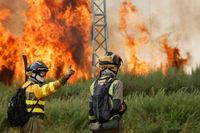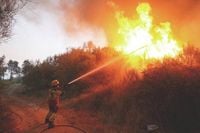Spain and its southern European neighbors are grappling with a wildfire crisis of historic proportions, as record-breaking temperatures and relentless drought fuel blazes that have scorched hundreds of thousands of hectares, devastated communities, and stretched firefighting resources to their limits. Over recent weeks, the infernos have swept through the Spanish regions of Galicia and Castile and Leon, as well as parts of Portugal, Turkey, and the Balkans, prompting mass evacuations, the closure of vital infrastructure, and an urgent call for international assistance.
On August 19, 2025, the Spanish government announced the deployment of an additional 500 soldiers to bolster the ranks of the 1,400 troops already battling approximately 20 active large-scale wildfires across the country, according to China Daily Global. By then, nearly 3,000 troops in total had joined firefighters in what Prime Minister Pedro Sánchez described as a critical effort to contain the devastation. "There will be some challenging days ahead and, unfortunately, the weather is not on our side," Sánchez warned, as quoted by China Daily Global. The Prime Minister had cut short his holiday in the Canary Islands to visit the affected areas and proposed a "grand state pact" to prepare Spain for future climate-related disasters. "We need to do a thorough analysis of how we can resize our prevention and response capabilities to the climate emergency," Sánchez said. "We must leave this issue outside of partisan strife. We are all part of the same state, and we must all work in the same direction."
Spain's hardest-hit region, Galicia, has been at the epicenter of the emergency. Alfonso Rueda, head of the Galician regional government, described the situation as dire, with firefighters still grappling with 12 major blazes and the threat to homes so acute that lockdowns and evacuations were ongoing. "Homes are still under threat, so we have lockdowns in place and are carrying out evacuations," Rueda said, as reported by AP and China Daily Global. The wildfires in Galicia have raged for more than a week, spreading rapidly near the city of Ourense, and forcing authorities to suspend Madrid-Galicia high-speed train services, according to Spain's national rail operator Renfe.
The State Meteorological Agency (AEMET) reported that temperatures in Spain hovered close to 45 degrees Celsius, with Cordoba recording a sweltering 44.7 degrees. AEMET declared the wildfire danger "extreme" across most of the country, warning on social media that "extraordinarily high temperatures are expected" and urging the public to take precautions. Galician authorities advised residents to wear face masks and limit outdoor activities to avoid inhaling smoke and ash, as the risk of heatstroke and respiratory issues loomed large.
The scale of destruction in Spain is staggering. According to the European Union's European Forest Fire Information System (EFFIS), 344,400 hectares—an area equivalent to the island of Mallorca—have burned so far in 2025, the largest area since records began in 2006 and more than four times the average for the period 2006-2024. The fires have claimed at least four lives in Spain in the past week alone, including a firefighter who died when his truck crashed near the village of Espinoso de Compludo. The loss of homes, businesses, and critical infrastructure has been widespread, with road and railway closures compounding the disruption.
Authorities have also faced challenges beyond the flames themselves. Defence Minister Margarita Robles told Cadena SER radio that thick smoke was hampering the efforts of helicopters and aircraft carrying water to extinguish the fires. "The fires have special characteristics as a result of climate change and this huge heatwave," Robles explained, noting that Spain had not experienced such a severe fire season in two decades. Since June, 27 people have been arrested and 92 are under investigation for suspected arson, according to Spain's Ministry of the Interior.
The crisis is not confined to Spain. Neighboring Portugal has been hit hard, with wildfires burning about 216,200 hectares so far this year—more than four times the 2006-2024 average, as reported by the EFFIS and the Portuguese Institute for the Conservation of Nature and Forests. Portugal's Civil Protection Agency said that over 4,000 firefighters, 1,300 vehicles, and 17 aircraft were deployed as of August 17-18, 2025. The country enacted a national state of alert on August 2, which was set to end as cooler weather approached, offering a glimmer of hope for exhausted crews.
Elsewhere in southern Europe, the situation has been equally grim. Greece, Bulgaria, Montenegro, and Albania have all requested assistance from the EU's firefighting force, which has already been activated as many times this year as during the entirety of last summer's fire season, according to the EU Copernicus Climate Change Service. The force's help has been crucial as flames threatened not just rural areas but also historic and cultural sites.
Turkey has suffered its own tragedy, with 19 deaths attributed to wildfires in recent weeks. In the northwest province of Canakkale, six villages were evacuated as a precaution, and around 1,300 firefighting personnel, backed by 30 aircraft, battled blazes near the Dardanelles Strait. The fires forced the closure of visitor facilities at Gallipoli, a site of immense historical significance marked by cemeteries and memorials from the World War I campaign. Hundreds of fires have erupted across Turkey since late June, fueled by record-breaking temperatures, dry conditions, and strong winds, according to the General Directorate of Forestry and local officials quoted by AP.
The underlying driver of these catastrophic wildfires, scientists and climate activists agree, is climate change. The EU's Copernicus Climate Change Service has observed that Europe has been warming at twice the global average since the 1980s, making the continent increasingly vulnerable to extreme heat and drought. "Scientists say that climate change is exacerbating the frequency and intensity of heat and dryness in parts of Europe, making the region more vulnerable to wildfires," China Daily Global reported. The EU estimates that 6,290 square kilometers of land have burned within its borders so far in 2025—the worst wildfire situation in two decades.
International cooperation has become vital as countries pool resources and expertise. Spain is awaiting the arrival of two Dutch water-dumping planes, set to join aircraft from France and Italy already assisting under a European cooperation agreement. Firefighters from other countries are expected to arrive in the coming days, Spain’s Civil Protection Agency chief Virginia Barcones told public broadcaster RTVE. Similarly, Portugal is expecting two Swedish firefighting planes as it looks to bolster its stretched resources.
As southern Europe endures one of its most severe wildfire seasons on record, the human, environmental, and economic toll continues to mount. With climate change driving ever more frequent and intense heatwaves, the need for robust, coordinated action—both to fight current fires and to prepare for future emergencies—has never been more urgent.
For residents and responders alike, the fight goes on—against the flames, the heat, and the daunting reality of a warming world.





